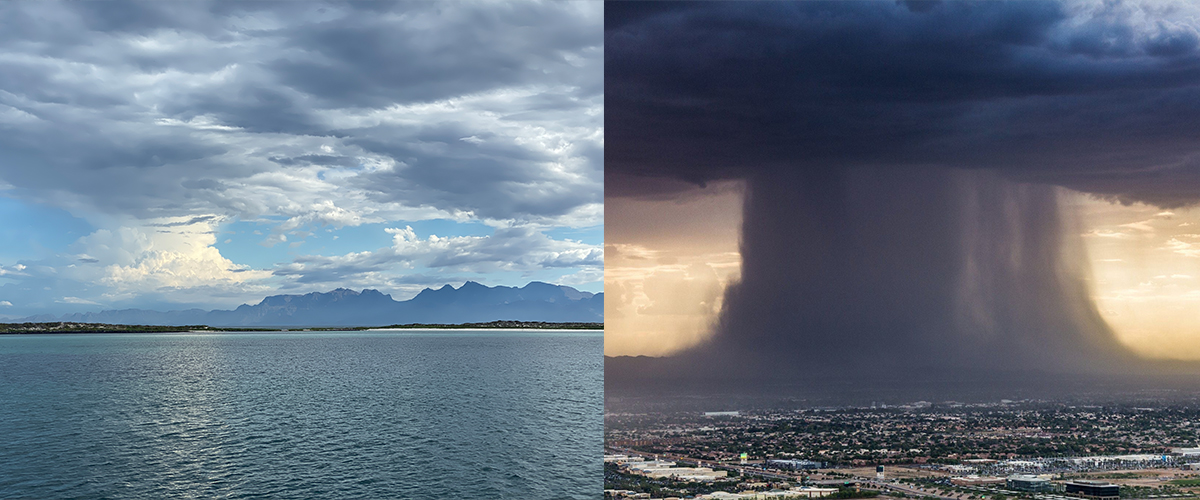

CHUBASCO TIME - BE PREPARED
It’s summer in the Sea of Cortez, and this is the first day I have seen any vertically developed cumulus clouds - a signal of what’s to come over the next few months.
We have had clear skies during May and June, but that is going to change.
How do I know?
The cruisers now get a Chubasco report every day focusing on convection.
When hot air rises, it’s called convection. If it rises a little bit, it creates puffy cumulus clouds that are wider than they are tall. Those cumulus clouds indicate fair weather.
But when hot air rises a great deal, the cumulus clouds get taller than they are wide - and when they go to 18,000 feet and develop an anvil top, you have a fully developed cumulonimbus cloud that can wreak havoc on a sailor’s life.
A Chubasco is a violet squall with thunder and lightning. Wikipedia puts it this way, “the word chubasco is used especially for suddenly occurring localised storms that produce very strong winds, sometimes as much as 90 miles per hour, and intense rains of as much as 5-6 inches in less than an hour. Straight-line winds can topple windmills and break large limbs of large, sometimes ancient trees. The phenomenon normally occurs during the hottest days of the year (May through October).”
In Phoenix I have been through many chubascos in the past ten years. In the Sea of Cortez, I have yet to experience one, and I am not looking forward to the experience while I am at anchor.
Chubascos come on fast, and they leave you fast. As long as your anchor holds, and other boat’s anchors do not drag, you will be fine as long as everything is secured on deck.
In Phoenix, I have seen chubascos where nine inches of rain fell in an hour beneath a massive cumulonimbus cloud accompanied by seventy mile an hour winds that blew down trees and toppled walls within a mile of our house. They are impressive short lived events punctuated with lots of thunder and lightning. The picture below is an extreme event - a microburst that looks like a nuclear weapon going off in Phoenix.
The massive cloud dumps hail and rain in a localized area, and the falling rain and hail bring the wind down with it. The wind may reach speeds over 100 miles per hour, and when the wind hits the ground it spreads out in every direction at 70 to 100 miles per hour.
In the ten years I lived in Phoenix, I have known of only two events as severe as this. They are at the far end of the chubasco spectrum, but they illustrate if you are in the wrong place at the wrong time, you could have a real problem. If your anchor can’t withstand winds up to 70 mph, you could be in real trouble.
Fortunately, most chubascos are not that severe, and conditions conducive to the formation of chubascos can be predicted with enough accuracy that you can prepare for them rather than get caught unawares.
The chubascos are coming, and for the rest of the summer we will take our anchoring extremely seriously. We will back down hard on our anchor with two engines in full reverse setting our anchor firmly into the seabed.
It would be a shame to get into trouble in chubasco land.
Awesome music video that captures the essence of what it's like to sail offshore in a catamaran around the world when conditions are less than perfect. David Abbott from Too Many Drummers sings the vocals, and he also edited the footage from our Red Sea adventures. This is the theme song from the Red Sea Chronicles.
Sailing up the Red Sea is not for the faint of heart. From the Bab al Mandeb to the Suez Canal, adventures and adversity are in abundance. If you take things too seriously, you just might get the Red Sea Blues.
If you like drum beats, and you like adventure, then have a listen to the Red Sea Chronicles Trailer.
Flying fish assault Exit Only in the middle of the night as we sail through the Arabian Gulf from the Maldives to Oman. And so begins our Red Sea adventures.
Sailing through Pirate Alley between Yemen and Somalia involves calculated risk. It may not be Russian Roulette, but it is a bit of a worry. Follow Team Maxing Out as they navigate through Pirate Alley.
Stopping in Yemen was just what the doctor ordered. We refueled, repaired our alternator, and we made friends with our gracious Yemeni hosts. We also went to Baskins Robbins as a reward for surviving Pirate Alley.
After you survive Pirate Alley, you must sail through the Gate of Sorrows (Bab Al Mandab) at the southern entrance to the Red Sea. The Gate of Sorrows lived up to its name with fifty knots of wind and a sandstorm that pummeled Exit Only for two days. Life is good.
Although I like the feel of a paper book in my hand, I love trees even more. When people purchase an eBook, they actually save trees and save money as well. Ebooks are less expensive and have no negative impact on the environment. All of Dr. Dave's books are available at Save A Tree Bookstore. Visit the bookstore today and start putting good things into your mind. It's easy to fill your mind with positive things using eBooks. No matter where you are or what you are doing, you can pull out your smart phone or tablet and start reading. You can even use electronic highlighters and make annotations in your eBooks just like paper books.